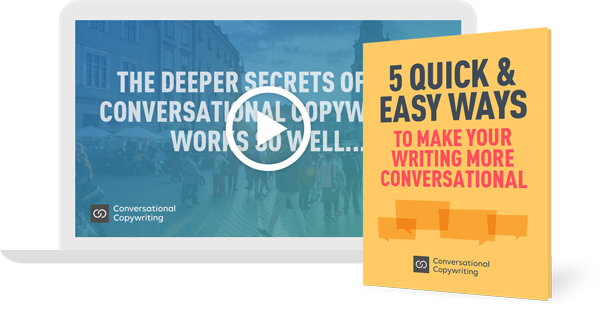
In this post I get to interview Value Proposition and Marketing Message Development Expert, Peter Sandeen.
That’s quite the title! But as you get to know Peter, the way he describes his work makes more and more sense.
And while I’ve known some of the people I interview here for 20 plus years, I have known Peter for about 20 days and counting.
Why the interview? Because after spending a little while on his website, and talking with him on the phone, I felt we shared a lot of common ground when it comes to our views on marketing.
That was enough to make me want to do this interview.
Let’s get started.
Nick: Peter, hi… and thank you for agreeing to do this.
To kick things off, I wanted to bring up a couple of sentences I found in the About Me section of your website.
You say: “I was raised to think marketing is wrong—or evil. As a child I thought it was about manipulating people into buying unnecessary things, so the marketer can get rich.”
I can totally relate to that. Truth be told, I still think it’s true of many of the products and services being pitched on the web!
I know when I started out as a copywriter I struggled for a while to find that line in the sand I didn’t want to cross… between being persuasive and being manipulative.
Does that still color your own thinking today? The idea that there is a boundary between the dark side and the light side?
Peter: Definitely, it’s something I think about quite often. Most of the marketing stuff I do and teach could just as well be done in a dishonest way.
Sometimes it’s really clear. People just lie.
But usually the dark side comes up as misleading statements. People say, “there won’t be a recording of this webinar,” but then they still have a “replay” available for a few days. Or they say, “this marketing tactic can create amazing results if you use it right,” but they don’t mention that it only works if you meet certain criteria. Or they say, “this is the lowest price for this offer ever,” but soon enough they sell a slightly modified version of the same offer at a lower price.
I rather stay quite black-and-white about it. If I know something might be misleading, I don’t do it or I specifically call out the likely misunderstanding. It seems safer and simpler, and it builds goodwill, too.
Nick: I like that… the idea of taking the extra step to call out any potential misunderstanding.
Something else I know we have in common is an impatience with bright and shiny objects when it comes to marketing online.
It drives me nuts when I’m bombarded with ads and emails telling me about 5 things, or 3 tools, or 7 killer tactics I can use to explode my business right now… today!
Nonsense… and a little bit evil.
In the way you describe your work it seems you are equally dismissive of these “miracle tactics” and want business owners to focus a lot more on developing their core messaging.
Can you tell us a little more about that… and why getting your message right is so important?
Peter: No one will ever say, “I bought your product because your Facebook ads are optimized” or “I bought your service because your sales funnel segmentation is so clever.”
People need to believe that buying your offer is worth it to them and that it’s their best option. That has nothing to do with the tactics you use. It’s what you communicate with those tools that affect what people believe.
And the usual solution of listing out tons of benefits… It’s why we all know the stereotype of a used-car salesman. They tell you so many positive things about their products that none of it means anything anymore.
So, you need to know what are the few most important things for your target customers. Then get those ideas across with your marketing; the tactics you use. That’s what makes people see the value they could get, so they want to buy.
Nick: I get similarly obsessed with finding the right message, and then using it as the foundation for all the marketing that follows.
But while I feel I’m up to speed with you on that topic, I’m way behind you – and trying to catch up – when it comes to creating a conversion path for any kind of business, whether you’re selling products or services.
I think I tend to associate conversion paths with marketing funnels. And when I find myself stuck in someone’s marketing funnel, I reach for the unsubscribe link as fast as I can.
But I have a sense your take on conversion paths is different.
It feels to me like you’re helping your clients build the backbone of an enduring business… and not just a path for this month’s promotional campaign.
Am I getting that right? Anyway… please tell us more about that.
Peter: I know what you mean by, “when I find myself stuck in someone’s marketing funnel, I reach for the unsubscribe link.” However, I don’t think the problem is the marketing funnel. The problem is how they do it.
If it feels like I’m trying to sell you something (if you haven’t asked me to do it), it’s annoying. So, instead of forcing people to hear a sales pitch before they’re interested, I structure the funnels so that we first make people understand the value they could get from you.
For example, the usual short funnel might use advertising to get people to a landing page where people join an email list, and then there’s a long sales video on the “thank you” page. It can work. But it’s not how I’d do it.
Instead, I’d have a no-sales (just teaching/value) video on the “thank you” page, which ends with something like, “If you’d like to hear how I can help you do X, Y, and Z, click the button below. There’s another video where I go through how I work with people.” So, someone who’s interested in working with me can watch the sales part. But I don’t annoy the other 50% of people.
People often get worried that they’d lose sales that way. But if you do this well, you make more sales (in my experience) because the first video can freely tell people about the benefits of the kind of thing you sell without people listening to it like a sales pitch. In other words, you can make people want something just like what you sell before they put their sales defenses up.
That’s, more or less, the idea of the usual 4-video launch sequence. The first videos get people interested in something like what you sell, and then by the time you talk about your offer, it’s something people see as valuable.
As for backbone vs. a quick campaign, it usually makes a lot more sense to build something that works in the background first (although, there are some exceptions). It doesn’t need to be “100% automated” or “the most advanced funnel ever.” It just needs to be something that works consistently.
An analogy I’ve been using is a bridge. If you have potential customers (who have not even heard of you yet) on this side of a river and reaching the other side means buying from you, you need to build a bridge. The whole bridge. People often get stuck building the first (how to reach new potential customers) and last pieces (how to convert the sales in the end). But if there’s even one missing part in the bridge, very few people will jump over. So, the “conversion path” is that bridge with all the pieces from the first contact all the way to the sales.
In 99% of cases, once you build it, you don’t need to rebuild it. You just improve it piece by piece.
Nick: That’s such good advice. And as a business owner myself, I find it reassuring that I can create a conversion path – or bridge – that will stand the test of time, with occasional tweaks.
It strikes me that a lot of what you say overlaps with my own obsession – Conversational Copywriting.
To me, conversational copywriting is about never being evil. It’s about being persuasive in an open and transparent way. Never about being manipulative.
I think it also speaks to your ideas on finding a powerful value message. Because that message should engage one’s audience.
In addition, I feel that the conversational approach to copywriting is a natural fit when creating a conversion path that endures.
Am I just fantasizing here, trying to make my own ideas “fit” – or do you agree? Do you think a more conversational approach to writing is a good match with what you teach?
Peter: It’s definitely a good match. My idea, in its simplest form, is that marketing is a way for you to make people who would value your offer understand that they really would value your offer.
You can do it in a non-conversational way, but that’s not as effective as doing it in a conversational way. People are more persuaded by conversational writing—it’s a well-established copywriting rule.
And when you know what exactly you should make people understand, so they want to buy, then it’s a lot easier to have a conversation (or write conversational copy) about it.
Nick: Peter, this has been great. I really appreciate your time and input. I’ll add some information and a link below, so people can get in touch with you.
Peter: Thanks, I hope people can see that before doing marketing, they should figure out what to say with their marketing, so it’s effective. Most marketing advice is about tactics, tools, and strategies. But remember that no one will ever say, “I bought from you because you use [insert marketing tactic/tool] so well.”
People buy when they understand the value they could get from you. And that’s about what you say with your marketing.
Peter Sandeen focuses on the fundamentals that make marketing consistently effective. Half of his clients are other marketing experts who want his help with marketing messaging, sales funnels, and conversion optimization. He’s known for being focused, straightforward, and practical. And many experts have adopted his processes and frameworks to simplify the most complex marketing topics. You can download his 2-page test to see how persuasive your marketing can be: petersandeen.com/value
Conversational Copywriting is the future of selling online. You can build your expertise now, or try catching up later. Find out about the course here…
